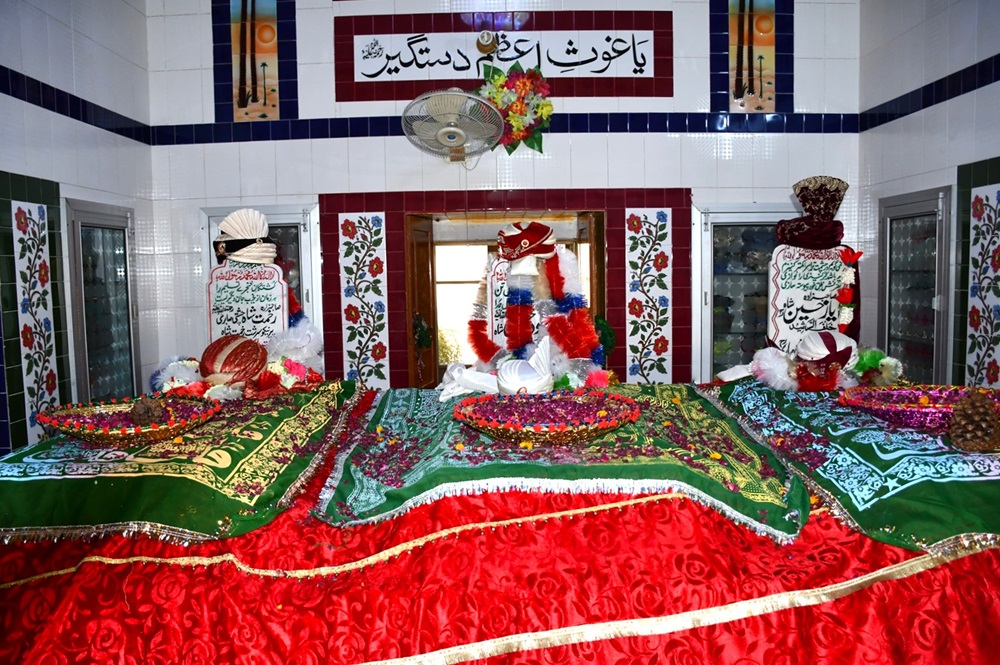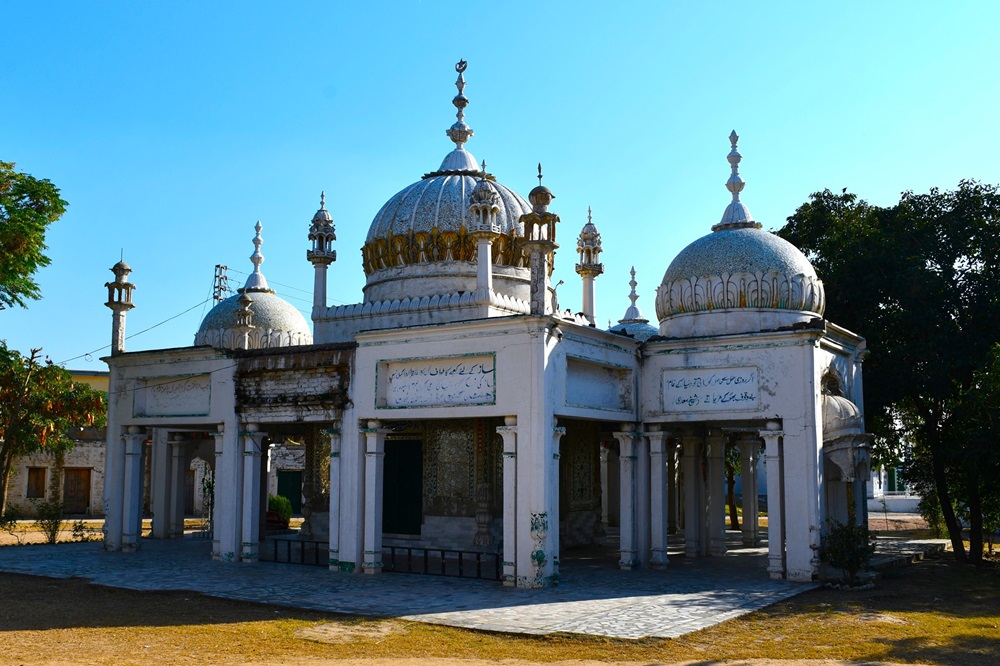Written by: Zulfiqar Ali Kalhoro
Posted on: January 15, 2024 |  | 中文
| 中文
Tomb of Pir Sabir Hussain Shah Chishti Sabiri, Proj Sharif Village. (Picture credits to Zulfiqar Ali Kalhoro)
Jand Mehlu, located in the Gujar Khan tehsil, is renowned for the shrines of the Chishti Sabiri saints, who were the descendants of Muhammad Abdullah Shah alias Dewan-e-Hazuri/Huzoori. Muhammad Abdullah Shah alias Dewan-e-Huzoori was an eminent Qadiri Sufi saint of Bishanduar in Jhelum district, who was born on 29 Shaban 974/ 20 March 1567 in Takhat Parri near Rawalpindi. Shah Nihaluddin, the father of Dewan-e-Huzoori, moved from Takhat Parri to Chakri Budhal village in Gujar Khan for preaching, where he died in 1025 AH/1616 AD and was buried there.
In Asrar ul-Muhbat (written in 1746), a Persian manuscript by Mian Abdullah Siham (d.1757), one learns an interesting piece of information that Dewan-e-Huzoori spent twelve years serving his spiritual mentor Shah Muhammad Bandigi Bukhari in Delhi. It is interesting to note that this information was not mentioned by any of the scholars who have written on Dewan-e-Huzoori. They only mentioned that Dewan-e-Huzoori went from Bagdad to become a deputy of Shah Muhammad Bandigi Bukhari. After his return from Delhi, he went to Chakrali to visit his parents, although his father had passed away by the time he came back. After some time, his mother also died, and he moved to Bishandaur, where he established his khanqah and preached Qadiri Silsila.
Bishandaur became a thriving centre of Qadiri Sufis in Pothohar, and many people became disciples and deputies of Dewan-e-Huzoori. Muhammad Abdullah Shah died on 20 Shawal 1072 AH/ 7 June 1662. He was buried at Bishandaur Sharif (now called Dewan Huzoori). He had two sons, Shah Abdul Aziz and Rehmatullah Shah. Dewan-e-Huzoori was succeeded by his eldest son, Dewan Shah Abdul Aziz, who later moved to Goleki in Gujrat, and his younger brother Rehmatullah Shah became Sajjada Nashin of the shrine of Dewan-e-Huzoori. Both brothers, Dewan Shah Abdul Aziz and Rehmatullah Shah, enthusiastically continued the success of Qadiriyya Silsila.
Later, descendants and deputies of Muhammad Abdullah Shah settled in different villages and towns of Punjab to spread the legacy of their ancestors. A few of them were initiated into different Sufi orders. One of them was Pir Rehmat Shah, who was popularly known as Rakhmat Shah. In the literature, he is referred to as Rehmat Shah, while on his gravestone and among the local community, he is called Rakhmat Shah.
Jand Mehlu village's main shrine is Pir Rehmat (Rakhmat) Shah Chishti Sabiri. I have visited this village several times to learn more about the shrine's history. Pir Rehmat Shah was a deputy of Molvi Abdul Sattar Chishti Sabiri (d.1942), who in turn was a deputy of Khwaja Fazaluddin Shah Chishti Sabiri. The shrines of Molvi Abdul Sattar and his spiritual mentor, Khwaja Fazaluddin Shah Chishti Sabiri (d.1891), are located in Gujar Khan’s Kalyam Sharif. Kalyam Sharif is the centre of Chishtiyya-Sabiriyya sufi saints from where many people were initiated into Chishtiyya-Sabiriyya silsila, and later they preached it in their respective areas.
Hasan Nawaz Shah (2013:36-37) notes in "Gujar Khan ke Suhrwardi Mashaikh" that Molvi Abdul Sattar Kalyami had four prominent deputies from the Gujar Khan tehsil. These deputies were Pir Rehmat Shah Sabiri, Pir Sabir Shah Sabiri, Sain Muhammad Noor and Sain Ghulam Hussain.
After receiving the robe of initiation from Molvi Abdul Sattar Kalyami, Pir Rehmat Shah began preaching the Chishtiyya-Sabiriyya order in Jand Mehlu village. As a result, Jand Mehlu emerged as a leading centre for the Chishtiyya-Sabiriyya silsila, attracting many individuals who sought to become his disciples. It is believed that he also started ‘Langar Ghousia’ in the village of Jand Mehlu. Sahibzada Maqsood Ahmad Sabiri (2012:221) writes in Warsan-e-Ilam o-Hikam that Pir Rehmat Shah was born to Pir Ghulam Nabi Shah in 1914 in the village of Jand Mehlu. Qazi Sultan Mehmood is believed to have proposed a name, and following his instruction, the individual was named Rehamt Shah. Qazi Sultan Mehmood (d. 1919) was a prominent Qadiri Sufi saint, whose shrine is located in Awan Sharif, Gujrat. According to "Maqalat-e-Mehmood" by Nawab Mashooque Yar Jang Bahadur (2004), Qazi Sultan Mehmood Qadiri was initiated into the Qadiriyya Silsila by Akhund Abdul Ghaffur (d. 1878), who was also known as Akhund Sahib or Saidu Baba. The shrine of Akhund Sahib is situated in Saidu Sharif, Swat.
Pir Rehamt Shah received early education in the madrasa of Qazi Said Ali Akbar in Moza Ahir near Missa Keswal village. One learns from the forthcoming book Tazkira Ulama-e Gujar Khan by Hasan Nawaz Shah that Qazi Said Ali Akbar was also known as Muhammad Ali Akbar. He was a famous religious leader of the area. He took bayat (an oath of allegiance to a Sufi master) from Pir Mehar Ali Shah Golarvi (d.1937). Hasan Nawaz Shah states in Tazkira Ulama-e-Gujar Khan that he was killed on 25th June 1931 during the recitation of the Holy Quran in a mosque due to a specific dispute.
After the death of Qazi Said Ali Akbar, Pir Rehamt Shah studied at the madrasa of Molvi Nek Muhammad in Moza Beval, Gujar Khan. He then moved to Lahore to continue his education at Darul Uloom Usmania. He studied at various madrasas under the guidance of esteemed religious scholars. Later, he became a deputy of Molvi Abdul Sattar Kalyami. His brother, Sabir Hussain Shah Chishti Sabiri, was also initiated into the Chishtiyya Sabiriyya Silsila by Molvi Abdul Sattar Kalyami. Later, at the instruction of his brother, Pir Rehamt Shah, Pir Sabir Hussain Shah settled in 1962 in the village of Proj Sharif to preach the teachings of the Chishtiyya Sabiriyya Silsila. This village eventually became a centre for the activities of these Chishti saints, and the local community responded positively to their teachings.

Grave of Pir Sabir Hussain Shah Chishti Sabiri at Proj Sharif. (Picture credits to Zulfiqar Ali Kalhoro)
Pir Rehmat Chishti Sabiri Shah passed away in 1969. In "Anwar-e-Rehmat", authored by Sahibzada Ayaz Hussain in 1990, it is noted that Pir Rehmat Shah had two sons: Sahibzada Masood ul Hasan and Sahibzada Ayaz Hussain Shah, the book's author. Regrettably, Sahibzada Masood ul Hasan passed away at the young age of ten in 1947. After the death of Sahibzada Rehmat Shah, his son Sahibzada Pir Ayaz Hussain Shah became the Sajjada Nashin (custodian) of the Darbar (shrine). He continued the legacy of his father, Sahibzada Ayaz Hussain Shah, who passed away in 1990.

Graves of Pir Rehmat Shah, Sahibzada Masood ul hasan and Sahibzada Ayaz Hussain, Jand Mehlu. (Picture credits to Zulfiqar Ali Kalhoro)
Pir Rehmat Shah Chishti Sabiri's tomb in Jand Mehlu village is the most visited shrine in the area. Inside the tomb, there are three graves. Upon entering, one will notice the grave of Pir Rehmat Shah Chishti Sabiri on the left, the grave of Sahibzada Masood ul Hasan in the centre, and the grave of Sahibzada Ayaz Hussain Shah on the right. To the north of the grave of Sahibzada Masood ul Hasan, a doorway leads to a covered verandah where the graves of Pir Rehamt Shah Chishti Sabiri’s mother and his wife, as well as the wife of Sahibzada Ayaz Hussain Shah are located.

Tomb of Pir Sabir Hussain Shah Chishti Sabiri at Proj Sharif. (Picture credits to Zulfiqar Ali Kalhoro)
The shrine of Pir Rehmat Shah Chishti Sabiri’s brother, Pir Sabir Hussain Shah Chishti Sabiri, is located in Proj Sharif, located 2 km from Gujar Khan town. Like his brother, he was also known for his piety and preached Chishtiyya-Sabiriyya Silsila in the village, and many people responded to his teachings. According to Sahibzada Maqsood Ahmad Sabiri (2012), he passed away in 1979, leaving behind three sons. Zafar Mehmood Shah is the custodian of the darbar whom I met in 2021. An impressive tomb has been built over his grave. The distinctive feature of the tomb are the four domes. The main and central dome crowns the grave of Pir Sabir Hussain Shah Chishti Sabiri, while three others crown the entranceways on the eastern, western and southern sides. Such an impressive tomb with four domes is not seen elsewhere in Gujar Khan tehsil. The tomb of Pir Sabir Hussain Shah Chishti Sabiri, much like the tomb of his brother Pir Rehmat Shah Chishti Sabiri at Jand Mehlu, is acclaimed for its ornate decoration and unique architectural style.
Sahibzada Maqsood Ahmad Sabiri (2012:219) states in Warsan-e-Ilam o-Hikam that Pir Mehmood ul Hasan Shah Chishti Sabiri received the robe of initiation from Pir Rehmat Shah Chishti Sabiri. The shrine of Sahibzada Pir Mehmood ul Hasan Shah Chishti Sabiri is within a short distance from the shrine of Pir Rehmat Shah Chishti Sabiri. A beautiful tomb is built over the grave of Pir Mehmood ul Hasan Shah Chishti Sabiri.
The revered shrines of the Chishti Sabiri saints, located in the villages of Jand Mehlu and Proj Sharif, serve as important pilgrimage sites for numerous devotees and visitors. Each year, during the celebration of the annual Urs (the death anniversary of a Sufi saint), these shrines transform into vibrant centres of spirituality and devotion, attracting thousands of people from the Pothohar region and beyond.
The writer is an anthropologist. He has authored 16 books on Pakistan's cultural heritage and anthropology. He tweets @kalhorozulfiqar.
You may also like: